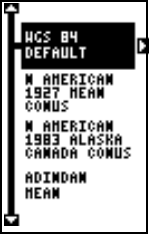
44
DATUM
Maps and charts are based on a survey of the area that’s covered by the
map or chart. These surveys are called “Datums”. Maps that are created
using different datums will show the same latitude/longitude in slightly
different locations.
All datums are named. The GPS system is based on the WGS-84 datum,
which covers the entire world. Other datums may also cover the entire
world, or just a small portion. By default, your position shows using the
WGS-84 datum. However, it can show your position using one of 191
different datums.
To change the datum, first press the MENU key, then
highlight the “GPS Setup” label and press the right ar-
row key. Now highlight the “Select Datum” label. Finally,
press the right arrow key again. A screen similar to the
one at right appears.
The WGS-84 label is highlighted. To change it, simply
press the up or down arrow keys to highlight the de-
sired datum, then press the ENT key. This selects the
datum and erases the select datum menu. To erase
the menu without changing the datum, simply press the EXIT key.
A list of the datums used by the GlobalNav 212 is in the back of this
manual.
PCF (Position Correction Factor)
Another method used to make your display match a chart or map is called
“PCF” or Position Correction Factor. This unit gives you the capability to
move or offset the position shown on the display to match one on the
chart. The unit will add this offset to all position and navigation displays at
all times.
Remember, the position error on any radio navigation system is very dy-
namic and the PCF offset should never be used in an attempt to cancel
the error.
In general terms, PCF should only be used if your map indicates what the
possible error is. PCF should always be reset to zero when you’re
finished with the chart.
For example, suppose you are stopped at a location that is accurately
marked on a chart. Your unit shows a longitude position that is .244 min-


















